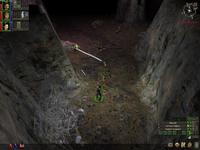|
|
|
Main News Forums Games Games Database Top 100 Release List Support Files Features Reviews Previews Interviews Editorials Diaries Misc Download Gallery Music Screenshots Videos Miscellaneous Staff Members Privacy Statement |
Random Dialogue: Persistently MMOGing Here Today Persistent worlds are virtual worlds that strive for a sense of ongoing existence. There aren't regular resets that wipe out player achievements and ostensibly there are events in the world that have a lasting impact. A result of this combination is that there is usually an attempt at an overarching plot. The ability to reliably deliver new and interesting content to the players drives this plot. In this context, the designers are looking at the rate at which the players will "consume" content. If they attempt to populate the world with all the content it will ever have from the outset they are forced to deal with a ridiculously long development and design time. If they attempt to have an ongoing "story" or a changing world, they are allowed leeway in adding content later in the game's lifetime. A setting that doesn't reset lets the designers and developers reach for the reality of a real, breathing world while continuing to entertain the existing player base. Of course, as with almost every virtual world, content additions and bug patches are necessary. With worlds of this sort, which ideally never shut down, these must be made during pre-announced downtimes that are schedule to affect the fewest possible users. Almost all of the most popular MMOGs today strive for this type of persistence. Epicly Repetitive Even in a supposedly persistent world, it is a sad state of affairs that the level of continuity that a player gets to experience is usually very poor. I've talked about endlessly repetitious quests before, so I won't dwell on the lack of impact that players have in most commercial games nowadays. I will quickly mention that any attempt at persistence is laughable if player actions have no impact on the world around them. The NPCs being able to remember your name after you've spoken with them several dozen times seems like a small thing to ask.
Gone Tomorrow The alternative to this sort of persistent world-space is a regularly resetting world. Character development is not saved. The world is usually reset to a "default" state every time the reset occurs. This is not necessarily always the same state. An ongoing story is much harder in a world of this type, but not impossible. If there is a story, it's likely to be episodic in nature and involve world-girding changes. While there are many MUDs that use this sort of persistence, the only commercial world that I know is planning on implementing it is eGenesis' incomparable game A Tale in the Desert. ATITD's plan is to set the game within specific timeframes the developers refer to as Tellings. The grand story of A Tale in the Desert was always meant to be episodic in nature. Pharaoh has stated that the second telling will likely be much shorter than the first. The reset and beginning of the new Telling will be very interesting to see happen. The players, hopefully, will enter the second telling without frustration over the restart of the game. I look forward to seeing the results of this intriguing design decision. Next Week
Next week, illness and meteor strike notwithstanding, I'll be talking about something the map-making GM in me will covet: Geography. Should the forest go right up to the city wall, or should there be a gap? Should the river pass through the orc lands or the human settled areas? Prepare for a descent into nit-picking. Next week. |
|||
|
All original content of this site is copyrighted by RPGWatch. Copying or reproducing of any part of this site is strictly prohibited. Taking anything from this site without authorisation will be considered stealing and we'll be forced to visit you and jump on your legs until you give it back. |
||




